NCERT Solutions Class 6 Maths
Chapter – 10 (Mensuration)
The NCERT Solutions in English Language for Class 6 Mathematics Chapter – 10 Mensuration Exercise 10.3 has been provided here to help the students in solving the questions from this exercise.
Chapter 10: Mensuration
Exercise – 10.3
1. Find the area of the rectangles whose sides are:
(a) 3 cm and 4 cm
(b) 12 m and 21 m
(c) 2 km and 3 km
(d) 2 m and 70 cm
Solutions:
(a) Area of the rectangle
= Length × Breadth
= 3 × 4 sq cm
= 12 sq cm
(b) Area of the rectangle
= Length × Breadth
= 12 m × 21 m
= 252 sq m
(c) Area of the rectangle
= Length × Breadth
= 2 km × 3 km
= 6 sq km
(d) 2 m = 2 × 100 cm = 200 cm
Area of the rectangle
= Length × Breadth
= 200 cm × 70 cm
= 14000 sq cm.
2. Find the areas of the squares whose sides are:
(a) 10 cm
(b) 14 cm
(c) 5 m
Solutions:
(a) Area of the square = Side × Side
= 10 cm × 10 cm
= 100 sq cm
(b) Area of the square = Side × Side
= 14 cm × 14 cm
= 196 sq cm
(c) Area of the square = Side × Side
= 5 m × 5 m
= 25 sq m.
3. The length and breadth of three rectangles are as given below:
(a) 9 m and 6 m
(b) 17 m and 3 m
(c) 4 m and 14 m
Which one has the largest area and which one has the smallest?
Solutions:
(a) Area of the rectangle = Length × Breadth
= 9 m × 6 m
= 54 sq m
(b) Length of the rectangle = Length × Breadth
= 3 m × 17 m
= 51 sq m
(c) Length of the rectangle = Length × Breadth
= 4m × 14m
= 56 sq m
Area of rectangle 56 sq m i.e (c) is the largest area and area of rectangle 51 sq m i.e (b) is the smallest area
4. The area of a rectangular garden 50 m long is 300 sq m. Find the width of the garden.
Solutions:
Area of the rectangular garden = 300 sq m
Length of the rectangular garden = 50 m
Area of rectangle = length × width
300 = 50 × width
width =
width = 6 m
∴ The width of the garden is 6 m
5. What is the cost of tiling a rectangular plot of land 500 m long and 200 m wide at the rate of ₹ 8 per hundred sq m.?
Solutions:
Length of the rectangular piece of land = 500 m
Breadth of the rectangular piece of land = 200 m
∴ Area of the rectangular piece of land = Length × Breadth
= 500 m × 200 m
= 100000 sq m
Cost of tiling 100 sq m = ₹
Cost of tiling 100000 sq m = ₹ x 100000
= ₹ 8000
6. A table top measures 2 m by 1 m 50 cm. What is its area in square metres?
Solutions:
Length of the table-top = 2 m
Breadth of the table-top = 1 m 50 cm = 1.50 m
∴ Area of the table-top = Length × Breadth
= 2 m × 1.50 m
= 3.0 sq m.
7. A room is 4 m long and 3 m 50 cm wide. Howe many square metres of carpet is needed to cover the floor of the room?
Solutions:
Length of the room = 4 m
Breadth of the room = 3 m 50 cm = 3.50 m
∴ Area of the room = Length × Breadth
= 4 × 3.5 sq. m
= 14.0 sq m
Hence, 14.0 square meters of carpet is needed to cover the floor of the room.
8. A floor is 5 m long and 4 m wide. A square carpet of sides 3 m is laid on the floor. Find the area of the floor that is not carpeted.
Solutions:
Length of the floor = 5 m
Breadth of the floor = 4 m
∴ Area of the floor = Length × Breadth
= 5m × 4m = 20sqm
Area of the square carpet = Side × Side
= 3m × 3m = 9sqm
∴ Area of the floor that is not carpeted = Area of the floor – Area of the square carpet
= 20 sq m – 9 sq m
= 11sq m.
9. Five square flower beds each of sides 1 m are dug on a piece of land 5 m long and 4 m wide. What is the area of the remaining part of the land?
Solutions:
Area of square flower bed = Side × Side
= 1 m × 1 m
= 1 sq m
∴ Area of 5 square flower beds
= 5 × 1 sq m
= 5 sq m
Length of the piece of land = 5 m
Breadth of the piece of land = 4 m
∴ Area of the piece of land = Length × Breadth
= 5 m × 4 m
= 20 sq m
∴ Area of the remaining part of the land
= 20 sq m – 5 sq m
= 15 sqm.
∴ Remaining part of the land is 15 m2
10. By splitting the following figures into rectangles, find their areas (The measures are given in centimetres).
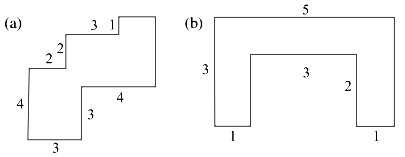
Solutions:
(a) Splitting the given figure into the rectangles I, II, III and IV, we have
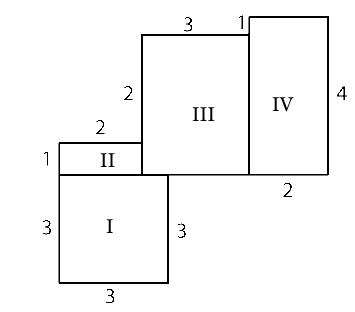
Area of the rectangle I = length x breadth
= 3 cm x 3 cm
= 9 sq cm
Area of the rectangle II = length x breadth
= 1 cm x 2 cm
= 2 sq cm.
Area of the rectangle III = length x breadth
= 3 cm x 3 cm
= 9 sq cm
Area of the rectangle IV = length x breadth
= 4 cm x 2 cm
= 8 sq cm
∴ Total area of the whole figure
= 9 sq cm + 2 sq cm + 9 sq cm + 8 sq cm
= 28 sq cm
(b) Splitting the given figure into the rectangles I, II and III, we get
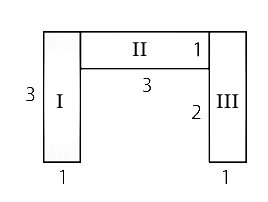
Area of the rectangle I = 12 cm x 2 cm
= 24 sq cm
Area of the rectangle II = 8 cm x 2 cm
= 16 sq cm
Area of rectangle III = 3 cm x 1 cm
= 3 sq cm
∴ Total area of the given figure = 3 sq cm + 3 sq cm + 3 sq cm = 9 sq cm.
11. Split the following shapes into rectangles and find their areas. (The measures are given in centimetres)
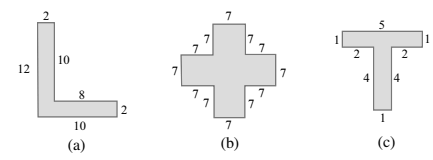
Solutions:
(a) Splitting the given figure into the rectangles I and II, we get.
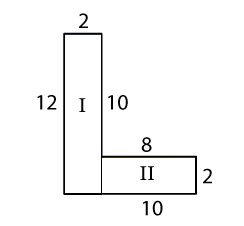
Area of the rectangle I = 12 cm x 2 cm
= 24 sq cm
Area of the rectangle II = 8 cm x 2 cm
= 16 sq cm
∴ Total area of the whole figure = 24 sq cm + 16 sq cm = 40 sq cm.
(b)
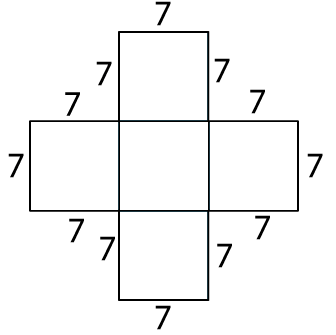
There are 5 squares. Each side is 7 cm
Area of 5 squares = 5 (7 cm x 7 cm)
= 5 x 49 sq cm
= 245 sq cm.
(c)
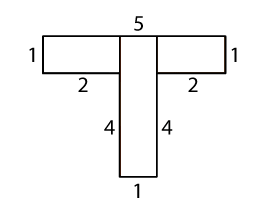
Area of the shape = ( 5 × 1 + 4 × 1) sq cm
= (5 + 4) sq cm
= 9 sq cm.
12. How many tiles whose length and breadth are 12 cm and 5 cm, respectively will be needed to fit in a rectangular region whose length and breadth are respectively?
(a) 100 cm and 144 cm
(b) 70 cm and 36 cm
Solutions:
Length of one tile = 12 cm
Breadth of the tile = 5 cm
∴ Area of 1 tile = length x breadth
= 12 cm x 5 cm
= 60 sq cm
(a) Length of the rectangular region = 144 cm
Breadth of the region = 100 cm
∴ Area of the rectangular region = length x breadth
= 144 cm x 100 cm
= 14400 sq cm
∴ Number of tiles needed to cover the whole rectangular region
= 14400 sq cm ÷ 60 sq cm
= 240 tiles
Hence, 240 tiles are needed
(b)
Length of the rectangular region = 70 cm
Breadth of the region = 36 cm
∴ Area of the rectangular region = length x breadth
= 70 cm x 36 cm
= 2520 sq cm
∴ Number of tiles needed to cover the whole rectangular region
= 2520 sq cm ÷ 60 sq cm
= 42 tiles.
Hence, 42 tiles are needed.

Leave a Reply